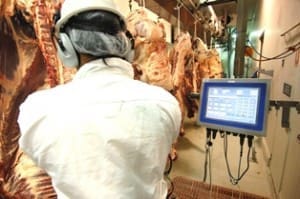THE pace of change might have slowed a little, but slaughter cattle prices – both via saleyards and direct consignment – have continued their downward trend this week.
Southeast Queensland and northern NSW grids seen this morning have best heavy cows back to 475-480c/kg this week, with the four-tooth heavy grassfed steer at 515-520c on competitive quotes.
 That’s a slide of at least another 20c on best grids seen last week on the cow, but nowhere near as severe on the grassfed steer which this time last week were quoted at 525-530c/kg – back 10c.
That’s a slide of at least another 20c on best grids seen last week on the cow, but nowhere near as severe on the grassfed steer which this time last week were quoted at 525-530c/kg – back 10c.
The reason for the harsher treatment on the cow is directly linked to the dramatic turbulence and lack of confidence that has emerged in the US export market over the past three weeks. Click here to view an earlier discussion about the events that have unfolded in the US imported meat market recently.
The other factor behind the steeper decline in cow price is the impact that US quota triggering, and consequent quota management is having on the manufacturing beef slaughter market.
As at October 15, Australia’s US quota usage was at 95 percent, leaving 22,465 tonnes of quota in exporters accounts. Since the 15pc of final quota access has been allocated in Australia (see earlier story), daily beef shipments from Australia to the US have fallen by close to 50pc.
Shipments for September were around 29,500t but are likely to continue to fall as available quota tightens and US domestic prices for grinding meat in the US also fall.
This current circumstance can be expected to last until around mid-November, exporters have told Beef Central, after which cow beef and lean trim being processed in Australia will not enter US ports until the 2016 quota year, when the limitation clears.
To put this week’s grid offers in perspective, while they represent a 65c/kg decline on the cow and around 35 or 40c on the steer, they remain a mile ahead of this time last year, when the same cattle were worth around 355-370c and 380-395c respectively.
It’s hard not to see further price declines ahead, especially on manufacturing beef type animals, unless there is some significant rain relief.
Saleyards numbers have started to retract in some selling centres over the past week, but prices have continued to trend cheaper. On popular lines, there is typically a 20c/kg advantage in weight-and-grade rates, currently, over equivalent saleyard returns – a typical trend in a falling market like this.
Having said that, there’s possibly a bigger proportion of saleyards cattle evident on kill rosters this week, as a consequence of the recent very large numbers passing through saleyards.
“If we can find a bit more room to take a few relatively cheaper saleyard cattle, then we will,” a processor contact said.
“But whether current slaughter numbers can be maintained is the key question. Much will demand on the weather.”
Current pricing is now closer to breakeven for many processor balance sheets, after chalking up some alarming losses on most slaughter cattle over the past three weeks, as meat markets and currency advantage deteriorated at the same time as cattle prices hit record highs.
Kills rise, as numbers continue to flow
There was a predictable rise in slaughter numbers across Eastern Australia last week, following on from a holiday-curtailed kill in larger states the week before.
NLRS reported a five-state tally of 160,880 head for the week ended Friday, up from around 140,000 the week before.
Heavy flows into saleyards due to hot dry weather and little immediate prospect of rain also fuelled that upturn. Most large export processors reported full rosters for the week to Friday.
Certainly even at current pricing, export meat markets would be unlikely to handle too much extra volume, so kills may stay at current levels for the time being.
“Given the state of the US at present, if you went to the market with more meat next week, you’d likely get your pants pulled down,” a processor source said.
While eight-day weather forecasts and beyond are often less predictable, there’s some confidence evident in some relief rain next week some time across the eastern half of Queensland, NSW and Victoria.
Cattle Markets might tighten if there is an inch or two across significant areas, but follow-up a week or two after that would be necessary to have any real influence on supply-demand for cattle, processors said.
“There will need to be two good falls a couple of weeks apart, to really see any significant benefit.”
While early seasonal plant closures looked to be on the cards only three or four weeks ago, plants now look likely to battle through to Christmas given current cattle flows, and while ever things stay as dry as they are. Decent rain would change that overnight, however.
Queensland’s kill rose a hefty 17pc last week due to the Labour Day holiday effect, lifting to 80,552 head. That’s still 5pc below this time last year.
NSW saw numbers lift 19pc for the same reason, reaching 37,250 head, still back 10pc on a year ago.
Victoria surged 7pc to almost 29,000 (13pc week-on-week); South Australia lifted 13pc to 9200; and Tasmania increased 14pc to 4930 as both large export plants got back to work.



HAVE YOUR SAY